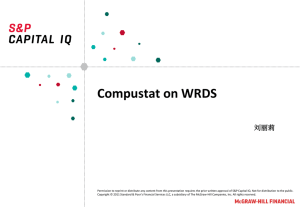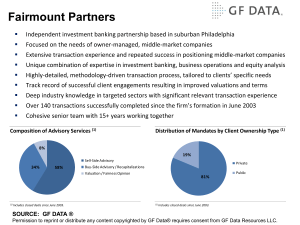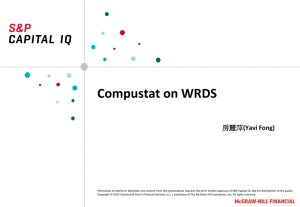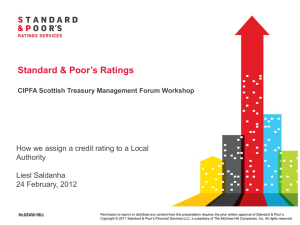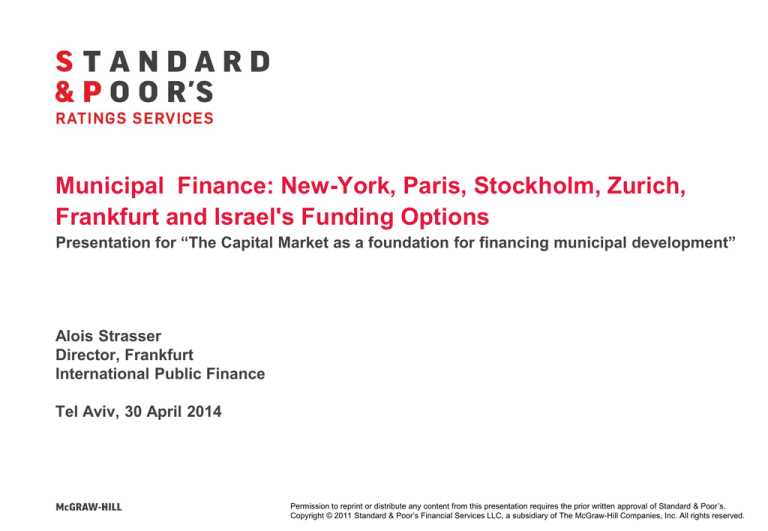
Municipal Finance: New-York, Paris, Stockholm, Zurich,
Frankfurt and Israel's Funding Options
Presentation for “The Capital Market as a foundation for financing municipal development”
Alois Strasser
Director, Frankfurt
International Public Finance
Tel Aviv, 30 April 2014
Permission to reprint or distribute any content from this presentation requires the prior written approval of Standard & Poor’s.
Copyright © 2011 Standard & Poor’s Financial Services LLC, a subsidiary of The McGraw-Hill Companies, Inc. All rights reserved.
Agenda
Global Funding Alternatives – Overview
US Municipal Bonds
French Twist Towards Capital Market Funding
Nordics And The Swedish Municipal CP Market
Swiss Tradition Of Capital Market Financing
German State Bond And Municipal Loan Market
Israel‘s Municipal Finance Approach
Permission to reprint or distribute any content from this presentation requires the prior written approval of Standard & Poor’s.
2.
Global Funding Alternatives - Overview
Permission to reprint or distribute any content from this presentation requires the prior written approval of Standard & Poor’s.
3.
Introduction And Overview
Our international methodology when rating local/regional governments
is based on combined quantitative and qualitative analysis of on eight
major components. Two of them are directly linked to funding:
– Institutional framework
– Economy
– Financial management
– Budgetary flexibility
– Budgetary performance
– Liquidity
– Debt burden
– Contingent liabilities
Permission to reprint or distribute any content from this presentation requires the prior written approval of Standard & Poor’s.
4.
Different Funding Alternatives
Municipal Finance Alternatives vary between
traditional bank loan markets, and
highly developed capital markets.
The use of funding instruments depends on historic developments,
specific legal frameworks and funding traditions, but also mirrors
changes in financial markets and investors.
Global developments suggest diversification of funding sources to
prevent dependence on single sources.
Permission to reprint or distribute any content from this presentation requires the prior written approval of Standard & Poor’s.
5.
European Local And Regional Governments Debt Stock By
Country 2013e (as % of total)
Source: Standard & Poors, 2014.
6
European Local And Regional Governments Debt Stock By
Country 2013e (Bil. Euros)
Rank 2013
2013e
Germany
1
767,1
Spain
2
248,8
France
3
134,7
Italy
4
119,8
U.K.
5
106,2
Switzerland
6
83,9
Norway
7
69,8
Sweden
8
54,0
Belgium
9
44,6
Austria
10
29,6
Finland
11
28,9
12
25,1
Denmark
Source: Standard & Poors, 2014.
7
European Gross Borrowing by Country 2013e (as % of total)
Source: Standard & Poors, 2014.
8
European Gross Borrowing by Country 2013e (Bil. Euros)
Rank 2013
2013e
Germany
1
144,5
Spain
2
56,9
Italy
3
18,9
Norway
4
18,9
Sweden
5
18,0
Switzerland
6
17,8
France
7
16,5
Finland
8
8,6
U.K.
9
8,0
Denmark
10
7,0
Austria
11
3,3
12
2,35
Belgium
Source: Standard & Poors, 2014.
9
US Municipal Bonds
Highly developed municipal bond market
– US states, municipalities and municipal enterprises fund
themselves on capital markets. Loan markets are not well
developed for such entities
– US municipals have particular structures (usually a pool of bonds
with maturities of 1 to 10 or 15 years).
– Benefit: Interest income of municipal bonds are exempt from state
income taxes, which is an incentive for private investors, but the
tax advantage is reflected in the pricing of municipal bonds
– Cheaper funding for municipalities
– Municipal bonds go together with ratings
Permission to reprint or distribute any content from this presentation requires the prior written approval of Standard & Poor’s.
10.
French Twist Towards Capital Market Funding
Change in banking environment led to change in funding strategies
– Historically traditional bank loan market with only few LRG issuing
bonds (Region Ile-de-France)
– Wind down of dominating municipal finance bank Dexia
suggested new orientation and strategies of LRGs towards capital
market financing
– In past 2 years more LRGs issued bonds, but also Schuldscheine
(transferrable loans)
– Ratings supported capital market access and diversification of
investors, particularly German mortgage banks
Permission to reprint or distribute any content from this presentation requires the prior written approval of Standard & Poor’s.
11.
French LRG Gross Borrowing
Permission to reprint or distribute any content from this presentation requires the prior written approval of Standard & Poor’s.
12.
Nordics And The Swedish Municipal CP Market
Nordic municipal finance market is characterized by strong municipal
funding vehicles (MFV)
• Denmark: Kommunekredit, Norway: Kommunalbanken, Sweden:
Kommuninvest, Finland: Municipality Finance
• Most MFV are bank-like institutions and only allowed to fund member
municipalities. Guarantee structures.
• MFV have very good capital market access, particularly to
international investors
Swedish LRG developed an active CP market. Swedish LRGs have high
exposure to ST debt and often operate as a group treasury also for its
municipal companies.
Bigger LRGs are also active in LT bond issues
Permission to reprint or distribute any content from this presentation requires the prior written approval of Standard & Poor’s.
13.
Nordic LRG Gross Borrowing
Permission to reprint or distribute any content from this presentation requires the prior written approval of Standard & Poor’s.
14.
Swiss Tradition Of Capital Market Financing
Swiss Franc Capital Market has a tradition of active bond issuances of
cantonal and city governments
Smaller municipal governments go for traditional bank or insurance
loans.
• Historically, Issuance Center For Swiss Municipalities (ESG), a
cooperative of Swiss municipalities, colleteced funding needs of
participating municipalities, bundles them in bond issues with cross
guarantee structures and issued bonds on the Swiss capital market.
• A default of one municipality and the subsequent call on provided
guarantees let to standstill of this funding option. The entity is in
liquidation.
• Cantons and bigger cities are frequent bond issuers and benefit from
high credit quality demonstrated through ratings
Permission to reprint or distribute any content from this presentation requires the prior written approval of Standard & Poor’s.
15.
Swiss LRG Gross Borrowing
Permission to reprint or distribute any content from this presentation requires the prior written approval of Standard & Poor’s.
16.
German State Bond And Municipal Loan Market
Historically, German LRGs funded themselves via loans of mortgage
banks which issued public sector Pfandbriefe (cover, collateralized
bonds)
– In early 2000s the Pfandbrief yield curve became particularly
unattracive for German states, as own bond issuances were
cheaper.
– Unattractive market conditions for mortgage banks led to a
reduction of public sector Pfanbriefe from € 800 billion in 2003 to
€220 billion in 2013. Alternatives?
– Since then huge shift from Schuldscheine as collateral for
mortgage bonds to state bonds (benchmarks, private placements)
of German states. Most of them benefit from ratings for bond
issuances.
Permission to reprint or distribute any content from this presentation requires the prior written approval of Standard & Poor’s.
17.
German State Bond And Municipal Loan Market (continued)
– Cities and municipalities got funding from mortgage banks and
local savings banks. Banking regulation and weaking credit
qualities of German cities required diversification of funding.
– Structures of joint bond issues of several cities and no ratings limit
market interest.
– Loans from German state development banks assist funding only if
state introduced loan subsidization programs
Permission to reprint or distribute any content from this presentation requires the prior written approval of Standard & Poor’s.
18.
German LRG Gross Borrowing
Permission to reprint or distribute any content from this presentation requires the prior written approval of Standard & Poor’s.
19.
Israel‘s Municipal Finance Approach
-
Mostly bank loan financing.
-
Only very few bond issues.
-
High dependence on willingness of banks to provide funding
-
Low diversity of funding options keep municipalities and cities
vulnerable
Permission to reprint or distribute any content from this presentation requires the prior written approval of Standard & Poor’s.
20.
Contacts
Ronit Harel Ben-Zeev
Eyal Lerer
CEO, Tel Aviv
Client Business Manager, Tel Aviv
Tel: +972/3/75397-03
Mobile: +972/54/4513107
ronit_harel@standardandpoors.com
Tel: +972/3/75397-17
Mobile: +972/50/7695582
eyal_lerer@standardandpoors.com
Ron Slomovits
Rating Analyst, Frankfurt
International Public Finance
Tel: +49/69/33999-245
Mobile: +49/175/5812595
ron_slomovits@standardandpoors.com
Etai Rappel
Associate Director, Tel Aviv
European Infrastructure Finance
Tel: +972/3/75397-18
Mobile: +972/54/6551343
etai_rappel@standardandpoors.com
Permission to reprint or distribute any content from this presentation requires the prior written approval of Standard & Poor’s.
21.
www.standardandpoors.com
Copyright © 2014 by Standard & Poor’s Financial Services LLC (S&P), a subsidiary of The McGraw-Hill Companies, Inc. All rights reserved.
No content (including ratings, credit-related analyses and data, model, software or other application or output therefrom) or any part thereof (Content) may be modified, reverse engineered, reproduced or distributed in any form
by any means, or stored in a database or retrieval system, without the prior written permission of S&P. The Content shall not be used for any unlawful or unauthorized purposes. S&P, its affiliates, and any third-party providers,
as well as their directors, officers, shareholders, employees or agents (collectively S&P Parties) do not guarantee the accuracy, completeness, timeliness or availability of the Content. S&P Parties are not responsible for any
errors or omissions, regardless of the cause, for the results obtained from the use of the Content, or for the security or maintenance of any data input by the user. The Content is provided on an “as is” basis. S&P PARTIES
DISCLAIM ANY AND ALL EXPRESS OR IMPLIED WARRANTIES, INCLUDING, BUT NOT LIMITED TO, ANY WARRANTIES OF MERCHANTABILITY OR FITNESS FOR A PARTICULAR PURPOSE OR USE, FREEDOM
FROM BUGS, SOFTWARE ERRORS OR DEFECTS, THAT THE CONTENT’S FUNCTIONING WILL BE UNINTERRUPTED OR THAT THE CONTENT WILL OPERATE WITH ANY SOFTWARE OR HARDWARE
CONFIGURATION. In no event shall S&P Parties be liable to any party for any direct, indirect, incidental, exemplary, compensatory, punitive, special or consequential damages, costs, expenses, legal fees, or losses (including,
without limitation, lost income or lost profits and opportunity costs) in connection with any use of the Content even if advised of the possibility of such damages.
Credit-related analyses, including ratings, and statements in the Content are statements of opinion as of the date they are expressed and not statements of fact or recommendations to purchase, hold, or sell any securities or to
make any investment decisions. S&P assumes no obligation to update the Content following publication in any form or format. The Content should not be relied on and is not a substitute for the skill, judgment and experience of
the user, its management, employees, advisors and/or clients when making investment and other business decisions. S&P’s opinions and analyses do not address the suitability of any security. S&P does not act as a fiduciary
or an investment advisor. While S&P has obtained information from sources it believes to be reliable, S&P does not perform an audit and undertakes no duty of due diligence or independent verification of any information it
receives.
S&P keeps certain activities of its business units separate from each other in order to preserve the independence and objectivity of their respective activities. As a result, certain business units of S&P may have information that
is not available to other S&P business units. S&P has established policies and procedures to maintain the confidentiality of certain non–public information received in connection with each analytical process.
S&P may receive compensation for its ratings and certain credit-related analyses, normally from issuers or underwriters of securities or from obligors. S&P reserves the right to disseminate its opinions and analyses. S&P's
public ratings and analyses are made available on its Web sites, www.standardandpoors.com (free of charge), and www.ratingsdirect.com and www.globalcreditportal.com (subscription), and may be distributed through other
means, including via S&P publications and third-party redistributors. Additional information about our ratings fees is available at www.standardandpoors.com/usratingsfees.
STANDARD & POOR’S, S&P, GLOBAL CREDIT PORTAL and RATINGSDIRECT are registered trademarks of Standard & Poor’s Financial Services LLC.
Permission to reprint or distribute any content from this presentation requires the prior written approval of Standard & Poor’s.
22.



